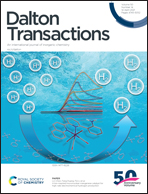Synthesis and characterization of new Pd(ii) and Pt(ii) complexes with 3-substituted 1-(2-pyridyl)imidazo[1,5-a]pyridine ligands†
Abstract
Several palladium(II) and platinum(II) complexes (1–20) of general formula [M(Ln)(X)(Y)] [M = Pd, X = Y = Cl (1-Cl–4-Cl), X = Y = OAc (1-OAc–4-OAc); M = Pt: X = Y = Cl (5–8); M = Pd, X = Cl, Y = CH3 (9–12); M = Pt, X = Cl, Y = CH3 (13–16) or X = Y = CH3 (17–20); n = 1–4] have been synthesized by reaction of different Pd(II) and Pt(II) derivatives with various 3-substituted 1-(2-pyridyl)-imidazo[1,5-a]pyridines; i.e.Ln = 1-(2-pyridyl)-3-arylimidazo[1,5-a]pyridine (aryl = Phenyl, L1; 2-o-Tolyl, L2; Mesityl, L3) and 1-(2-pyridyl)-3-benzylimidazo[1,5-a]pyridine (L4). Detailed spectroscopic investigation (including IR, mono- and bi-dimensional 1H NMR) and elemental analysis has been performed for all these species, allowing their complete characterization. Ln act as N,N-bidentate ligands and coordinate the metal centers in a chelate fashion through the pyridyl (Npy) and the pyridine-like nitrogen atom of the imidazo[1,5-a]pyridine group (Nim). The X-ray structural analysis performed on two of Pd(II) and three Pt(II) complexes, namely [Pd(L2)(CH3)Cl] (10), [Pd(L3)(CH3)Cl] (11) and [Pt(L1)Cl2] (5), [Pt(L4)Cl2] (8), [Pt(L2)(CH3)Cl] (14) confirmed the spectroscopic and analytical data. Finally DFT studies unveiled the structural reasons behind the inertia of the synthesised compounds toward metalation, identified as the higher angle steric strain in comparison with the analogous bipyridine complexes.
![Graphical abstract: Synthesis and characterization of new Pd(ii) and Pt(ii) complexes with 3-substituted 1-(2-pyridyl)imidazo[1,5-a]pyridine ligands](/en/Image/Get?imageInfo.ImageType=GA&imageInfo.ImageIdentifier.ManuscriptID=D1DT00546D&imageInfo.ImageIdentifier.Year=2021)


 Please wait while we load your content...
Please wait while we load your content...